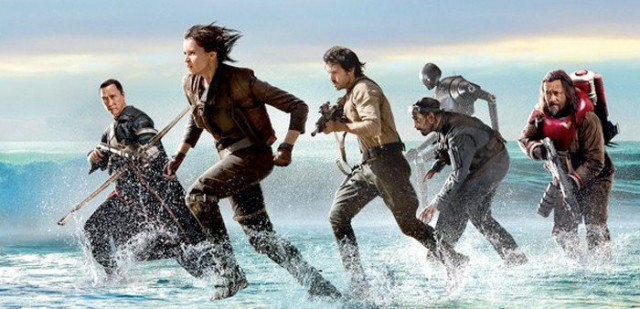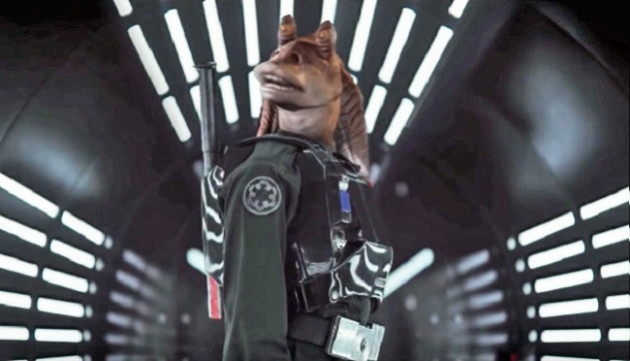There’s a famous line in Star Wars that was the general audience’s introduction into the power of backstory. It was uttered by Luke Skywalker. “You fought in the Clone Wars?”
The Clone Wars, all of us Star Wars fans marveled. What the fuck are those and how do I learn more?
You see, backstory is, in many ways, just as important as present story. Not for the audience. But for you, the writer. The more you know about the past, the more it will inform the present. And it lends itself to lines like that, which imply a bigger broader story, one that existed before, and will exist after, the story you’re telling. It’s sort of like a hack that makes movies feel more like real life.
Let me give you another example. Let’s say I’m writing a robbery scene. In the scene, a couple robs a home. Specifically, they’re looking for jewelry. As Kim Kardashian’s Paris heist taught us, jewelry’s got a ton of value yet it’s very portable. I want you to imagine this scene in your head. Go ahead, stop reading the article and play it out. How does it look?
I’m guessing generic. The couple pops into the house, looks for the bedroom where the jewelry is most likely to be, encounters a few obstacles. Maybe the family even comes home during the robbery and the couple has to escape without being noticed.
An okay scene. But now let’s start applying backstory. Let’s figure out what’s going on with this couple. Maybe the woman has been pressing the man to propose for awhile but he won’t do it. It’s a sore spot in the relationship.
Now let’s send them back into the house. This time, however, when the woman is rummaging through the jewelry, she comes across this gorgeous engagement ring. In the previous scene iteration, this ring means nothing. But now, with backstory added, it’s a reminder of what she wants and doesn’t have.
You could take this in a number of directions. It could spark an argument between the couple. It could be the “aha” moment she needs to realize what her life has become – following around a loser, robbing houses, when he won’t even commit to her. Maybe she walks out right then and there. Or it could be like the Clone Wars line – a simple peek into the past. She picks up the ring, stares at it, we see a sadness in her eyes, and that’s it. She throws it in the bag and keeps going.
However you look at it, backstory is now working for you. And again, this is just one tiny example. We didn’t get into the guy’s backstory. Why he’s robbing houses. What he needs the money for. That backstory would inform the scene as well.
And if you’re a real backstory junkie, you could think about who lives at this house and figure out THEIR backstory. That’s right. I’m encouraging you to create backstory for a character we don’t even meet!
What if, for example, they discover that the owner of the house has terabytes of child porn. What began as a routine robbery now becomes something much bigger. What if this man was rich and our couple realized there was a bigger payday at play here? They could use the child porn to blackmail the home owner.
The power of backstory! Just learning a few things about the past has already made this scene much better.
But let’s get back to our featured player – Rogue One – because it’s one of the more elaborate examples of backstory working for the present story.
The original Star Wars starts with a Rebel ship that has just stolen the plans to a super weapon. Now the amateur screenwriter knows the barest number of details that allow him to get this opening scene up and running. He doesn’t know what this ship was doing five minutes before he cut it on it. And he definitely doesn’t know what the characters were going through an hour ago. He focuses only on the here and now, and, as a result, he writes a scene that’s very static, very predictable. There can’t be any surprises if one doesn’t understand the specific events that got us here.
George Lucas, however, who we know tirelessly slaved over this story – he knows everything that went on before the Empire caught up with the Rebel ship. And it’s what helped inform Star Wars and make it one of the most specific science-fiction stories ever.
Am I saying that George knew every story beat that occurred in Rogue One before he wrote Star Wars. No. Am I saying he knew that Jyn Erso led the charge? No. Obviously, they had to change a lot of details from George’s notes to make Rogue One a standalone movie (and not just backstory). But you can bet a sandtrooper’s bottom that George knew how those plans were stolen and how they got to the point where the Empire was chasing them.
But this brings up a compelling question. When should backstory be relegated to backstory? And when should backstory be part of the present story? When should we see it? The answer to that question comes down to a few factors.
Is the backstory compelling, dramatic, or exciting? If so, it might be worth it to find a way to place it in the current story. In doing the backstory for Hoth (the ice planet in Empire Strikes Back), Lucas may have discovered that it was once heavily populated with Wampas (giant snow monsters). That’s cool! So it would make sense, then, to find a storyline where you could use a Wampa (and they do, as one kidnaps Luke).
Does it screw with the fluidity of the story? If it does, it may not be worth it. Star Wars could’ve technically began with the stealing of the Death Star plans. Would it have worked? Maybe. But it’s a little cleaner to start on the ship that’s just escaped. The Clone Wars, by comparison, are easy to ditch. They would’ve required us to start the movie 20 years prior before making an odd cut to the present. Talk about screwing with fluidity. It should be noted, however, that Rogue One starts 20 years in the past, setting up Jyn Erso’s character as a child. So it’s a judgement call. However, fluidity should always be taken into account.
Does the backstory tell us a lot about your character? This is the hardest call to make in regards to backstory. Character is so important and the more you know about someone, the more you care about them. So it’s in your best interest to tell us as much about a character as possible. The problem is, if we’re watching your character dick around for 30 minutes before the story revs into action, we’re going to get bored. So you have to find a balance. Luke’s introduction in Star Wars is one of the braver segments of the film. We stay with this very quiet sequence of a boy stuck on a farm for a long time. Technically, we could’ve introduced him, have him go pick up a droid, come back to find his aunt and uncle dead, and sent him off to Mos Eisley. All that stuff about Luke wanting to leave and join the Rebellion would’ve become backstory. But by seeing that day-to-day inner conflict with our own eyes, it ensured that we fell in love with Luke. On the flip side of that, one of the complaints about Rey in The Force Awakens is that we didn’t know her well enough. And that may have been because Abrams sped us along through her Jakku segment too quickly. He decided to make other parts of her past backstory (indeed, we hear about other Rey-Jakku segments that were cut from the film). So backstory is always a judgement call with character. Try and find a balance.
The last thing I’ll say about backstory is that you don’t want to become too obsessed with it. If you’re focusing so much on backstory that you’re not writing your screenplay, you probably need to stop. When backstory obsession becomes writer’s block, switch over to writing the script. Because, ironically, one of the best ways to find backstory is to write about the present.
Good luck on your backstory journeys. The rest of the day will be my backstory to seeing Rogue One tonight! Review tomorrow!!!



